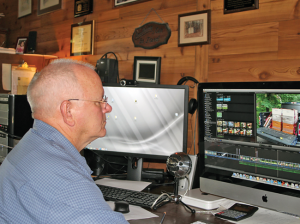
James E. Tew
Stay Connected
http://onetew.com
By James Tew
Some of my colonies died during the Winter – should I have done more or less The rough and ready world of honey bee webinars
Normalcy – in everything – is always changing
Normal today is not necessarily normal tomorrow. When I was a young boy, on Mother’s Day in church, all those people whose Moms were still living wore a red flower while all of those parishioners whose Moms had passed wore white flowers. Typically, women wore stylish hats and men wore suits adorned with neckties. Not today. There’s not a single hat on a female head – no matter the age, and only a few ties around the necks of aged men. It’s normal today to be much more casually dressed. The Mother’s Day corsages are gone, too.
It’s normal to use a mobile phone. Phone booths are gone. As a kid, I had access to three black & white TV channels. Now the number of channels to which I have access is nearly unreasonable. (. . . and there is still not a lot to watch). How many more of these acculturalization changes do we need to list here? Things change. Bee industry normalcy has certainly changed, too.
Today’s Beekeeping normality
“Yeah, yeah, you’ve already said how cheap queens once were and how many swarms came your way in the 70s. We get it. Bee life was better then.” You would be correct to have that notion – except all aspects of bee life in the 70s was not necessarily better. Things were different, but not always better. However, in this piece, “better and why” is not the direction I want to take. I want to stay right here in the present.
Present-day beekeepers’ colonies have Varroa and queen issues. That’s normal. Honey crops are lower than they were. Normal. Pollination fees are much higher. Typical. Winter losses at 40 to 50 percent – not unheard of. Nearly normal. Whoa, whoa, whoa . . .
I’m becoming punchy at the suggestion that losing as much as 50% of our wintering colonies is the new normal. That crude percentage may be correct, but it certainly shouldn’t be called normal – but that’s just my opinion. However, I am the guy cleaning deadouts and replacing them. So I am authorized and opinion – right?
It’s my complaining time of the year
It’s the time of the year when I write “winter-loss frustration pieces.” I am particularly frustrated for new beekeepers whose eagerness has been dampened by the harsh reality of winter-kills. If beekeeping were easy, I suppose everyone would be keeping bees, but truth-be-told, wintering bees has not always been this difficult.
My wife who is also one of my several editors for these articles told me that this particular piece was negative. I honestly don’t mean to be negative in any of my pieces, but I do mean to directly address the perpetual frustration of managing winter-killed colonies and replacing them during late Winter or early Spring. If not normal, the process has certainly become routine. Dealing with deadouts is simply not a positive aspect of beekeeping and that fact cannot be ignored.
Beekeeping in the space between problems and answers
In years past, I wrote an article or two about how beekeepers must manage today’s bees without needed answers. We know the problems – Varroa, chemical pesticides, queen genetics – but we don’t yet have ready answers. How do we manage our colonies while we wait for answers and updated recommendations? In many instances, beekeepers must become their own R&D people. Sometimes “help” is simply not on the way. We all have access to the Internet, so potential solutions for our problems seem to appear nearly monthly. Yep, new answers and cutting-edge procedures are posted there all the time, but to a great degree, most solutions and answers have disappointed and faded. Otherwise, we would all be happy with our wintering colonies survivability.
Wintering . . . specifically
Several general stresses are affecting colonies throughout the season, but I specifically want to address wintering management procedures. I tend to blame all my bee management woes on Varroa and its secondary viral invaders. I know that we have lost floral resources and our queen stock seems wiggy at times. The thing is that I literally see both Varroa and the related effects of Varroa. I can actually see this huge problem in my colonies. Even if I have other bee problems, Varroa seems to the leader of my colonies ills. Next spring, I will try again (and again) to set up a control program to suppress mite populations.
U.S. beekeeping varies
U.S. beekeeping looks the same across the country. All U.S. beekeepers use the same styles of equipment and they buy that equipment from essentially the same vendors. But wintering bees in the South is simply not the same as wintering colonies in the North. Duh . . . Winter weather simply cannot be ignored. A cold Winter is hard on colonies. Southern beekeepers may have other Winter (dearth) issues, but a good, long, cold Winter is a real test of the colony’s ability to survive and the beekeeper’s ability to help the colony survive. This cold weather thing is simply a seasonal variation, but it is a demanding one.
If I may, a conclusion – beekeepers managing colonies during a true Winter are dealing with a huge “normal” challenge. Those in warmer areas may not feel as much pain.
Bee and beekeeper life in the cold zone
It gets cold in NE Ohio where I and my bees live. Even so, it gets much colder in states to the north and west of me and my bees. I have no lock on Winter weather challenges. In preparation for winter, I have piddled around with various Varroa control procedures. Most of these products and procedures work to some degree, but none have readily killed mites without considerable labor and expense – that I provide.
In my article title above, I wrote that some of my colonies died during the past Winter months. Last Fall, should I have done even more to get these colonies through the Winter? Though it may be insulting to some of you, should I ask if I should have done less? The Winter that is just passing has been particularly cold and long. Many nights, the temperature dropped to zero degrees or even lower. Would investing even more time and money last Fall really have helped. What in the world should I recommend to new keepers (and old ones)? Do more. Do less. I’m working on this one.
What’s practical here?
I am not as young as I once was. I cannot commit unlimited energy and finance to a single aspect of my life or my bee life. Last Fall, I did the perfunctory tasks that assured me that I would be tormenting/killing mites. I allocated plenty of food reserves, and I had as good a cadre of queens (as was practical) in my colonies. The population of my colonies was average to good. Even so, it appears that I am going to have about the usual Winter loss as other recently past Winters – around 35%.
To do more would require more miticide product, more labor and time, and closer monitoring my colonies’ queens. At every step, more time and expense. If I had invested even more time and money in my colonies, the Winter my bees just experienced would have seemingly killed more colonies anyway. (Of course, I can’t prove that). Would the survival of more of my colonies have justified more and more input from me?
In light of my six grandkids, house and barn maintenance, gardening, social obligations, traveling, and maintaining my interest in photography and webinar presentations, should I have put even more time in colony Winter preparation? Or, should I do a decent job of preparing colonies for the Winter – hope for a mild one – and make up the Winter-kills with splits, packages and maybe the capture of a few swarms?
Losing 35 – 40% per Winter is frustrating. I can’t deny that. I’m hardheaded now. You remember that old guy I discussed above who remembered honey bees from the old days? Years ago, beekeepers didn’t have to do all of this extra work or deal with this extra expense. I suppose that in the deepest part of my bee soul, I am still thinking that – somehow – some way – a few divinely inspired simple procedures will put me and my bees back where we once were.
Well, I’m certainly not giving up
No doubt, I will be right here exactly a year from now – frustrated by the same events, but I will try to – some way – become more efficient when completing my winter prep work. It is profoundly clear that the bees are doing all they can do to help themselves and yet, colonies are still dying. It’s up to Beekeeper Jim to make the changes that will help the bees help themselves.
So, I will do more than I did last year. What else can I do? New ideas, new products and the interest in the insulating attributes of polystyrene hive equipment could help forestall the effects of future hard Winters. One secret place that I plan to search is the old beekeeping literature when wintering help was much more extensive. Then – as now – bees are comparatively expensive. Some of the old guys actually buried their colonies. Some kept their colonies in bee houses year-round. As with current queen management recommendations, our established Winter management recommendations fail all-too-often. What I am presently doing seems to be about 65-75% effective. I have some plans to change a few management procedures. I will keep you informed as next Fall approaches. I hope a new normal is on the horizon. What novel wintering plans do some of you have?
The rough and ready world of honey bee webinars
In 1996, I was elated to get significant funding to develop and produce a satellite-delivered beekeeping class. It was a 14-part beta tape series. At the time, the series was high quality. We subsequently sold many VHS tape sets to both bee groups and individual beekeepers1. About one per year, I still get a comment or two. Each production was about an hour long. It was young person’s project. The physical labor input and stress was significant. The events were live with no time delay (Much like today’s webinars – what you say or do is what immediately goes to the world.) We went to Mexico, Texas, Washington, DC, and visited local beekeepers everywhere to accumulate footage.
The project worked very well. The only drawback was that you needed a satellite dish – the old huge ones – to see it in real time. I was instantly hooked on the concept of remote site presentations – either live at the moment or segments that went live at a later time2. At the end of each presentation, events were recorded and released in a stored format – usually the VHS tapes.
Through the years, I had the opportunity to work with different sponsors to produce both recorded and live video segments. Presently, I am involved with Editor Kim on a project that has been named the Kim and Jim Show. This is a newish avenue and a newish concept, but one that the Bee Culture staff is steadily improving. Presently, anyone with a smart phone can capture and post a video. Yes, it’s true. We are all potential videographers. Some productions are better than others, but sometimes a poor video movie of a novel event – a load of bees overturning or a mating queen and drone on the ground, or possibly a raccoon undergoing a bee attack, would make for an interesting video – never mind the quality.
Webinar producers still have to address some consistent issues and opinions. (1) Many beekeepers still say, “Yes, one of those webinars would be good, but it is so much better if you are actually here.” Saddens me to say, that statement is still true. But as a meeting coordinator, I can have quality speakers for small fraction of the cost and energy compared to having someone spend a weekend flying and talking and then flying home. Webinars can really protect a bee club’s budget bottom line. (2) Using webinars too much or too often can damage a club’s bottom line. If a beekeeper has the log-in information, the presentation can be watched from home. For the present time, a typical meeting should balance the number of live events at the meeting with an occasional cameo webinar event. Generally, a webinar should support but not replace a live speaker roster. (3) Always, always always have a disaster plan loaded and ready to go. Bandwidth issues, WiFi connectivity, computer or hardware failure can happen. For me, audio is the most challenging aspect of presenting a live webinar. The longest minutes of a meeting organizer’s life can be those spent trying to get the remote speaker on line while either a live audience or a virtual audience, or both watches. (4) From a remote speaker’s perspective, webinars are uniquely frightening. In my personal case, I have no Internet technology specialist sitting at my elbow. If something goes wrong, it is my problem to correct (immediately) and get back to a placidly presented bee talk. If there are real challenges, why even bother with this technology?
Because when it works and it usually does, it is stunning technology. Editor Kim just presented from New Zealand. It worked flawlessly, but this event should be his story. I’ll say no more. This Internet presentation technology is going to evolve and grow. I cannot imagine what the next few decades will bring. I am so glad that I am still active enough to have had an opportunity to use this evolving technology. Maybe we can talk sometime – virtually. All those years ago, Dick Tracy was not too far off the mark. (Who was Dick Tracy?) (Google it.)
 1As an aside, one commercial vendor pirated the tapes, reproduced them and sold lower quality sets. Purchasers would then contact me to complain about the low video quality of the set. That was a bit difficult to endure.
1As an aside, one commercial vendor pirated the tapes, reproduced them and sold lower quality sets. Purchasers would then contact me to complain about the low video quality of the set. That was a bit difficult to endure.
2In 2011, a tornado destroyed the honey bee storage facility. All of the video masters to this program were destroyed. VHS tapes still exist. I have posted two short clips from this early satellite work at: Tracheal Mite http://bit.ly/2pgfBhD
Dr. James E. Tew, State Specialist, Beekeeping, The Alabama Cooperative Extension System, Auburn University, Emeritus Faculty, Entomology, The Ohio State University; Tewbee2@gmail.com; http://www.onetew.com; One Tew Bee RSS Feed (www.onetew.com/feed/); http://www.facebook.com/tewbee2; @onetewbee












